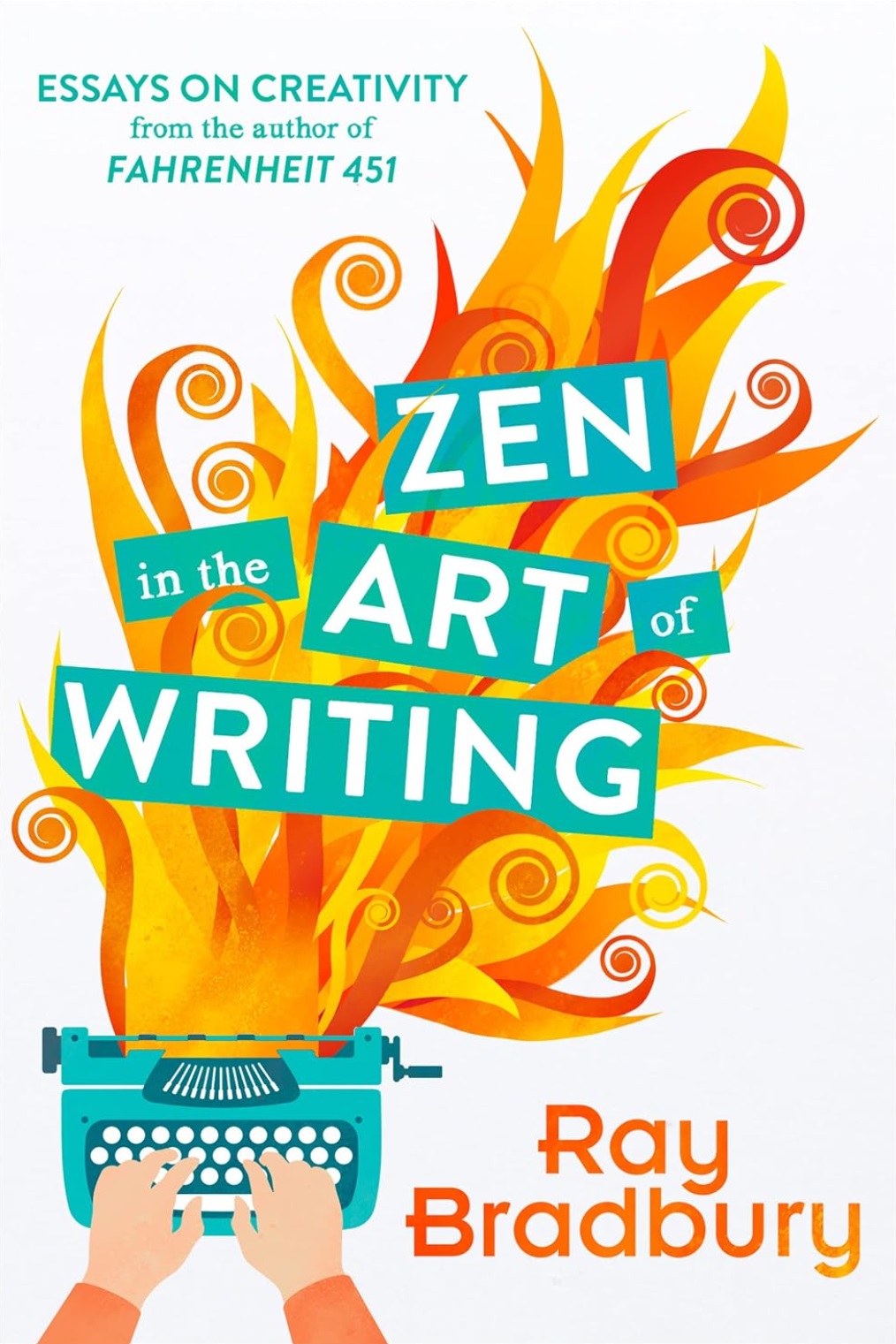Zen in the Art of Writing by Ray Bradbury is a collection of essays celebrating the joy, passion, and discipline of writing. Bradbury’s enthusiastic approach encourages writers to rediscover their love for storytelling and to embrace creativity as a daily practice.
Through personal reflections and metaphorical insights, Bradbury reminds writers that the craft of writing is not just about work—it’s about play, exploration, and following your instincts.
Table of Contents
ToggleIntroduction
Overview of the Book
Zen in the Art of Writing by Ray Bradbury is a collection of essays that delve into the joys, challenges, and discipline of the writing craft. First published in 1990, this compilation reflects Bradbury’s passion for writing and his infectious enthusiasm for creativity.
Drawing from his extensive experience as a prolific author, Bradbury offers a blend of personal anecdotes, advice, and reflections, all centered on the idea that writing should be an act of joy.
Unlike many technical guides to writing, Zen in the Art of Writing focuses on the emotional and spiritual aspects of being a writer. Bradbury encourages writers to embrace their passions, follow their instincts, and cultivate the discipline needed to achieve success in their craft.
His essays convey the belief that writing is not only a profession but a way of life—a practice that requires both a deep commitment and an open heart.
Why This Book is Important for Writers
Bradbury’s Zen in the Art of Writing offers inspiration and motivation for writers of all levels. Rather than focusing on rigid rules or techniques, Bradbury emphasizes the importance of writing with passion and enthusiasm.
His essays are filled with personal wisdom, and his playful, imaginative approach to writing encourages readers to rediscover the joy of storytelling.
For writers who feel burned out, uninspired, or disconnected from their work, this book serves as a powerful reminder of why they fell in love with writing in the first place.
The book also explores the idea of discipline, with Bradbury advocating for daily writing as a way to unlock creativity and sharpen one’s skills. His philosophy blends hard work with a sense of play, making Zen in the Art of Writing both a practical and uplifting guide for writers seeking to find balance between passion and perseverance.
Author Background
About the Author
Ray Bradbury was one of the most influential American authors of the 20th century, known for his contributions to the science fiction and fantasy genres. His most famous works include Fahrenheit 451, The Martian Chronicles, and Something Wicked This Way Comes.
Bradbury’s career spanned over seven decades, during which he wrote novels, short stories, screenplays, and essays, becoming a literary icon renowned for his vivid imagination and poetic prose.
Bradbury’s writing is characterized by its lyrical style, imaginative plots, and deep exploration of human emotions and society. Throughout his life, he maintained a relentless dedication to writing, producing thousands of stories and essays. His experiences as a writer—marked by discipline, joy, and persistence—are at the heart of Zen in the Art of Writing.
Relevance of the Author’s Experience to the Book
Bradbury’s prolific career and passion for storytelling make him uniquely qualified to offer advice on the craft of writing.
His essays in Zen in the Art of Writing reflect his own approach to creativity and work ethic. Bradbury’s personal journey as a writer—from his early struggles to his eventual success—offers readers valuable insights into the importance of persistence, playfulness, and love for the craft.
His long career as a writer also gives him the authority to speak on both the practical and emotional aspects of writing, making the book deeply relatable for writers at all stages.
Book Structure and Style
Layout and Chapter Overview
Zen in the Art of Writing is structured as a collection of essays, each focusing on different aspects of the writing life. Some essays explore the philosophical side of writing, such as the importance of passion and instinct, while others offer practical advice on discipline, routine, and creativity.
Throughout the book, Bradbury shares stories from his own life as a writer, reflecting on the lessons he has learned and the habits that have sustained him throughout his career.
Notable essays in the collection include “The Joy of Writing,” where Bradbury celebrates the sheer pleasure of creating stories, and “Drunk, and in Charge of a Bicycle,” where he discusses the importance of following one’s creative instincts. The variety of essays ensures that the book covers a wide range of topics, from writing discipline to the power of imagination.
Writing Style and Tone
Bradbury’s writing style in Zen in the Art of Writing is energetic, joyful, and often poetic. His enthusiasm for writing is palpable in every sentence, and his love for storytelling shines through in his vivid, imaginative prose.
Bradbury’s tone is encouraging and playful, making the book an enjoyable and motivating read for writers. He speaks with the wisdom of experience, but his tone is never condescending—rather, it is full of wonder and excitement about the creative process.
Bradbury’s prose is also filled with metaphor and imagery, as he likens writing to everything from flying to dancing to playing. This figurative language creates a sense of magic around the craft of writing, encouraging writers to approach their work with a sense of freedom and adventure. His style invites readers to see writing not as a chore or obligation, but as a joyous and fulfilling pursuit.
Key Takeaways for Aspiring Writers
Practical Advice and Techniques
One of the central pieces of advice in Zen in the Art of Writing is the importance of writing every day. Bradbury believes that the act of writing should become a daily practice, much like meditation or exercise.
By writing regularly, writers can keep their creative muscles in shape, allowing their ideas and skills to develop over time. This emphasis on routine and discipline serves as a reminder that writing is not just about inspiration—it’s also about hard work and consistency.
Bradbury also encourages writers to embrace their passions and write about what excites them. He advocates for following one’s instincts and writing from a place of joy, rather than trying to conform to trends or expectations. This advice is particularly valuable for writers who may feel disconnected from their work or are struggling to find their creative voice.
Another practical takeaway from Bradbury’s essays is the importance of play in writing. He views writing as an act of discovery and experimentation, encouraging writers to let go of their inhibitions and allow their imaginations to take the lead. This playful approach to storytelling can help writers overcome fear and self-doubt, opening up new possibilities for creative expression.
Theoretical Insights and Perspectives
In addition to practical advice, Zen in the Art of Writing offers deeper philosophical reflections on the nature of creativity and the writer’s role in the world. Bradbury sees writing as an essential part of being human, a way to make sense of the world and to communicate with others on a profound level. He believes that stories have the power to shape society and to reveal truths about the human condition.
Bradbury also explores the relationship between creativity and intuition. He encourages writers to trust their instincts and to allow their subconscious mind to guide them through the creative process.
This perspective aligns with his broader belief that writing should be a joyful and liberating experience, rather than one bound by rigid rules or expectations.
Strengths of the Book
Unique Features and Approaches
One of the standout features of Zen in the Art of Writing is Bradbury’s infectious enthusiasm for the craft. His passion for storytelling is evident in every essay, and his joy is contagious.
Writers who may be feeling burnt out or discouraged will find this book to be a powerful source of inspiration and motivation. Bradbury’s playful approach to writing also sets the book apart from other writing guides, which often focus on discipline and technique without addressing the emotional and spiritual aspects of the craft.
Bradbury’s use of metaphor and imagery adds a layer of artistry to the book, making it a pleasure to read. His ability to blend practical advice with poetic reflections creates a unique reading experience that appeals to both the intellect and the imagination. This makes Zen in the Art of Writing not only a guide to writing, but also a celebration of the creative process.
Applicable to Different Levels of Writers
The book is accessible and valuable to writers at all stages of their careers. For beginners, Bradbury’s encouragement to write from a place of joy and passion can help them find their voice and build confidence in their abilities. The emphasis on daily writing and discipline provides a solid foundation for developing a consistent writing practice.
For more experienced writers, Bradbury’s reflections on creativity and intuition offer a refreshing perspective on the writing process. His essays remind seasoned writers of the importance of staying connected to the joy and wonder that first drew them to storytelling. The philosophical insights in Zen in the Art of Writing can help reinvigorate the creative spirit, making it a valuable resource for writers at any stage.
Areas for Improvement
Potential Weaknesses or Gaps
While Zen in the Art of Writing is an inspiring and enjoyable read, it may not provide enough concrete, technical advice for writers who are looking for specific guidance on improving their craft.
Bradbury’s focus is more on the emotional and philosophical aspects of writing, rather than on practical tips for things like plot development, character creation, or editing. Writers seeking detailed instruction on the mechanics of storytelling may need to supplement this book with more technical writing guides.
Additionally, Bradbury’s advice to “write with joy” may not resonate with every writer, particularly those who view writing as a more disciplined or structured pursuit.
His emphasis on passion and playfulness may feel less applicable to writers working on longer, more complex projects that require careful planning and organization. While Bradbury’s approach is freeing and inspiring, it may not suit writers who prefer a more methodical approach to their craft.
Audience Suitability
The book is ideal for writers who are looking for inspiration and motivation, rather than those seeking technical instruction. It’s particularly well-suited for writers who may be struggling with burnout or a loss of creative passion.
However, writers who are looking for specific tips on how to improve their writing technique may not find the detailed guidance they need in Zen in the Art of Writing. The book is more focused on reigniting the writer’s love for the craft and encouraging them to embrace creativity as a joyful, instinctive process.
Additionally, Bradbury’s emphasis on spontaneity and writing with enthusiasm might not resonate with writers who prefer a more methodical, planned approach to their work. While his encouragement to follow one’s passion is uplifting, it may not offer the practical structure some writers need, especially those who thrive on organization, outlining, or rigorous plotting.
How This Book Compares to Other Writing Guides
Similar Books in the Genre
Zen in the Art of Writing can be compared to other books that focus on the emotional and philosophical aspects of writing, such as Brenda Ueland’s If You Want to Write and Anne Lamott’s Bird by Bird.
Like Ueland, Bradbury emphasizes the importance of joy and passion in writing, encouraging writers to connect with their instincts and embrace creativity with enthusiasm. Both books serve as motivational guides rather than technical manuals, aiming to help writers rediscover the love for their craft.
Compared to Bird by Bird, Bradbury’s essays are less focused on the practical aspects of writing and more on the emotional and spiritual side of the craft.
While Lamott offers a blend of practical advice and personal anecdotes, Bradbury leans heavily on metaphor and poetic musings, making Zen in the Art of Writing a more abstract and philosophical read.
Distinguishing Factors
What sets Zen in the Art of Writing apart from other writing guides is Bradbury’s unique blend of infectious enthusiasm and poetic reflection. His essays are filled with metaphor, imagery, and a palpable love for storytelling, which elevates the book beyond a simple writing manual.
Bradbury’s advice is deeply personal and rooted in his own experience, making the book feel like a conversation with a wise and passionate mentor.
Another distinguishing feature is Bradbury’s emphasis on play and joy. While many writing guides focus on discipline, structure, and overcoming obstacles, Bradbury’s philosophy centers around the idea that writing should be a joyful, playful process.
His approach encourages writers to reconnect with their childlike sense of wonder, reminding them that creativity thrives when it’s fueled by passion and excitement.
Real-World Application for Writers
How Writers Can Implement the Advice
Writers can start by adopting Bradbury’s recommendation to write daily. The discipline of writing regularly, even if only for a short time each day, can help writers stay connected to their creative flow and develop consistency in their work.
This practice allows writers to explore their ideas without fear of judgment or perfection, encouraging them to experiment and follow their instincts.
Another important takeaway from the book is the idea of writing from a place of joy and passion. Writers can implement this advice by focusing on topics or stories that genuinely excite them, rather than trying to conform to external expectations or trends.
Bradbury’s message is clear: when writers are enthusiastic about their work, it shines through in the final product, and the writing becomes more authentic and engaging.
Bradbury also encourages writers to embrace the act of play in their storytelling. By letting go of inhibitions and allowing their imaginations to roam freely, writers can open up new creative possibilities and avoid getting stuck in rigid patterns. This sense of creative freedom can lead to more innovative, daring, and exciting work.
Benefits of Following the Book’s Advice
Writers who follow Bradbury’s advice are likely to experience a renewed sense of enthusiasm for their craft. By focusing on writing with joy and passion, they can break free from the pressure of perfectionism and rediscover the excitement that first drew them to storytelling.
Writing from a place of love, as Bradbury suggests, not only makes the process more enjoyable but also leads to more authentic, engaging work.
Additionally, the practice of daily writing can help writers build discipline and momentum in their work.
By committing to a regular writing routine, writers can improve their skills over time and develop the habit of showing up to the page, even on days when they may not feel inspired. This consistency can lead to greater productivity and a deeper connection to their creative process.
Conclusion
Summary of Key Insights
Zen in the Art of Writing by Ray Bradbury is a joyful, passionate celebration of the writing life. Through a collection of essays, Bradbury offers writers advice on embracing creativity, following their instincts, and writing with enthusiasm.
The book emphasizes the importance of daily writing, discipline, and playfulness, encouraging writers to reconnect with their love for storytelling.
While it doesn’t focus on the technical aspects of writing, Zen in the Art of Writing provides invaluable motivation and inspiration for writers seeking to rediscover their passion.
Final Recommendation
For writers who are feeling burnt out, uninspired, or disconnected from their work, Zen in the Art of Writing is an essential read. Bradbury’s infectious enthusiasm for storytelling and his joyful approach to the creative process serve as a powerful reminder of why writing is such a rewarding and fulfilling pursuit.
While the book may not provide detailed, technical advice on the craft, its focus on the emotional and philosophical aspects of writing makes it a valuable resource for writers at all stages of their careers.
Whether you’re a seasoned writer in need of a creative boost or a beginner looking to cultivate your passion for writing, Zen in the Art of Writing offers the inspiration and encouragement needed to embrace the craft with joy and excitement.











